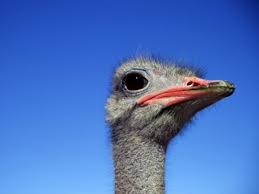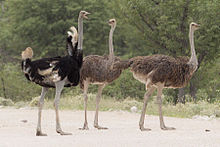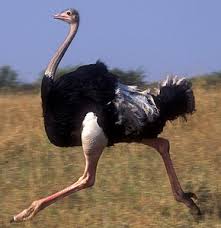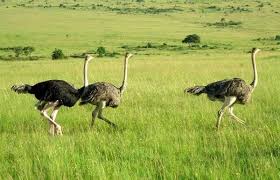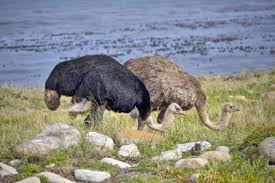The ostrich or common ostrich is either one or two species of large flightless birds native to Africa, the
only living member(s) of the genus Struthio, which is in the ratite family. In 2014, the Somali ostrich
(Struthio molybdophanes) was recognized as a distinct species.
The ostrich shares the order Struthioniformes with the kiwis, emus, rheas, and cassowaries. However,
phylogenetic studies have shown that it is the basal extant member of Palaeognathae and is thus equally
closely related to flighted tinamous. It is distinctive in its appearance, with a long neck and legs, and
can run at up to about 70 km/h (19 m/s; 43 mph), the fastest land speed of any bird. The ostrich is the
largest living species of bird and lays the largest eggs of any living bird (extinct elephant birds of
Madagascar and the giant moa of New Zealand laid larger eggs).
The ostrich's diet consists mainly of plant matter, though it also eats invertebrates. It lives in nomadic
groups of 5 to 50 birds. When threatened, the ostrich will either hide itself by lying flat against the
ground, or run away. If cornered, it can attack with a kick of its powerful legs. Mating patterns differ by
geographical region, but territorial males fight for a harem of two to seven females.
The ostrich is farmed around the world, particularly for its feathers, which are decorative and are also used
as feather dusters. Its skin is used for leather products and its meat is marketed commercially, with its
leanness a common marketing point.
Description
Ostriches usually weigh from 63 to 145 kilograms (139-320 lb), or as much as two adult humans. Ostriches of
the East African race (S. c. massaicus) averaged 115 kg (254 lb) in males and 100 kg (220 lb) in females,
while the nominate subspecies (S. c. camelus) was found to average 111 kg (245 lb) in unsexed adults.
Exceptional male ostriches (in the nominate subspecies) can weigh up to 156.8 kg (346 lb). At sexual maturity
(two to four years), male ostriches can be from 2.1 to 2.8 m (6 ft 11 in to 9 ft 2 in) in height, while
female ostriches range from 1.7 to 2.0 m (5 ft 7 in to 6 ft 7 in) tall. New chicks are fawn in colour, with
dark brown spots. During the first year of life, chicks grow at about 25 cm (9.8 in) per month. At one year
of age, ostriches weigh approximately 45 kilograms (99 lb). Their lifespan is up to 40-45 years.
The feathers of adult males are mostly black, with white primaries and a white tail. However, the tail of one
subspecies is buff. Females and young males are greyish-brown and white. The head and neck of both male and
female ostriches is nearly bare, with a thin layer of down. The skin of the female's neck and thighs is
pinkish gray, while the male's is blue-gray, gray or pink dependent on subspecies.
The long neck and legs keep their head up to 2.8 m (9 ft) above the ground, and their eyes are said to be the
largest of any land vertebrate: 50 mm (2.0 in) in diameter; helping them to see predators at a great distance.
The eyes are shaded from sunlight from above. However, the head and bill are relatively small for the birds'
huge size, with the bill measuring 12 to 14.3 cm (4.7 to 5.6 in).
Their skin varies in colour depending on the subspecies, with some having light or dark gray skin and others
having pinkish or even reddish skin. The strong legs of the ostrich are unfeathered and show bare skin, with
the tarsus (the lowest upright part of the leg) being covered in scales: red in the male, black in the
female. The tarsus of the ostrich is the largest of any living bird, measuring 39 to 53 cm (15 to 21 in) in
length. The bird has just two toes on each foot (most birds have four), with the nail on the larger, inner
toe resembling a hoof. The outer toe has no nail. The reduced number of toes is an adaptation that appears
to aid in running, useful for getting away from predators. Ostriches can run at a speed over 70 km/h (43 mph)
and can cover 3 to 5 m (9.8 to 16.4 ft) in a single stride. The wings reach a span of about 2 metres
(6 ft 7 in), and the wing chord measurement of 90 cm (35 in) is around the same size as for the largest
flying birds. The feathers lack the tiny hooks that lock together the smooth external feathers of flying
birds, and so are soft and fluffy and serve as insulation. Ostriches can tolerate a wide range of
temperatures. In much of their habitat, temperatures vary as much as 40 °C (100 °F) between night and day.
Their temperature control mechanism relies on action by the bird, which uses its wings to cover the naked
skin of the upper legs and flanks to conserve heat, or leaves these areas bare to release heat. The wings
also function as stabilizers to give better maneuverability when running. Tests have shown that the wings
are actively involved in rapid braking, turning and zigzag maneuvers. They have 50-60 tail feathers, and
their wings have 16 primary, four alular and 20-23 secondary feathers.
The ostrich's sternum is flat, lacking the keel to which wing muscles attach in flying birds. The beak is
flat and broad, with a rounded tip. Like all ratites, the ostrich has no crop, and it also lacks a
gallbladder. They have three stomachs, and the caecum is 71 cm (28 in) long. Unlike all other living birds,
the ostrich secretes urine separately from faeces. All other birds store the urine and faeces combined in
the coprodeum, but the ostrich stores the faeces in the terminal rectum. They also have unique pubic bones
that are fused to hold their gut. Unlike most birds, the males have a copulatory organ, which is retractable
and 20 cm (8 in) long. Their palate differs from other ratites in that the sphenoid and palatal bones are
unconnected.
Distribution and habitat
Ostriches formerly occupied Africa north and south of the Sahara, East Africa, Africa south of the rain
forest belt, and much of Asia Minor. Today ostriches prefer open land and are native to the savannas and
Sahel of Africa, both north and south of the equatorial forest zone. In Southwest Africa they inhabit the
semi-desert or true desert. Farmed ostriches in Australia, Israel and New Mexico have established feral
populations. The Arabian ostriches in the Near and Middle East were hunted to extinction by the middle of
the 20th century. Ostriches have occasionally been seen inhabiting islands on the Dahlak Archipelago, in the
Red Sea near Eritrea.
Feedin
They mainly feed on seeds, shrubs, grass, fruit and flowers; occasionally they also eat insects such as
locusts. Lacking teeth, they swallow pebbles that act as gastroliths to grind food in the gizzard. When
eating, they will fill their gullet with food, which is in turn passed down their esophagus in the form of a
ball called a bolus. The bolus may be as much as 210 ml (7.1 US fl oz). After passing through the neck
(there is no crop) the food enters the gizzard and is worked on by the aforementioned pebbles. The gizzard
can hold as much as 1,300 g (46 oz), of which up to 45% may be sand and pebbles. Ostriches can go without
drinking for several days, using metabolic water and moisture in ingested plants, but they enjoy liquid
water and frequently take baths where it is available. They can survive losing up to 25% of their body
weight through dehydration.
Behaviour
Ostriches normally spend the winter months in pairs or alone. Only 16 percent of ostrich sightings were of
more than two birds. During breeding season and sometimes during extreme rainless periods ostriches live in
nomadic groups of five to 100 birds (led by a top hen) that often travel together with other grazing animals,
such as zebras or antelopes. Ostriches are diurnal, but may be active on moonlit nights. They are most active
early and late in the day. The male ostrich territory is between 2 and 20 km2 (0.77 and 7.72 sq mi).
With their acute eyesight and hearing, ostriches can sense predators such as lions from far away. When being
pursued by a predator, they have been known to reach speeds in excess of 70 km/h (43 mph), and can maintain
a steady speed of 50 km/h (31 mph), which makes the ostrich the world's fastest two-legged animal. When
lying down and hiding from predators, the birds lay their heads and necks flat on the ground, making them
appear like a mound of earth from a distance, aided by the heat haze in their hot, dry habitat.
When threatened, ostriches run away, but they can cause serious injury and death with kicks from their
powerful legs. Their legs can only kick forward.
Predators
As a flightless species in the rich biozone of the African savanna, the ostrich must face a variety of
formidable predators throughout its life cycle. Animals that prey on ostriches of all ages may include
cheetahs, lions, leopards, African hunting dogs, and spotted hyenas. Ostriches can often outrun most of their
predators in a pursuit, so most predators will try to ambush an unsuspecting bird using obstructing
vegetation or other objects. A notable exception is the cheetah, which is the most prolific predator of
adult ostriches due to its own great running speeds.
Common predators of nests and young ostriches include jackals, various birds of prey, warthogs, mongoose and
Egyptian vultures. If the nest or young are threatened, either or both of the parents may create a
distraction, feigning injury. However, they may sometimes fiercely fight predators, especially when chicks
are being defended, and have been capable of killing even their largest enemies, the lions, in such
confrontations.



